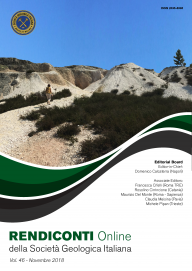
La sequenza sismica dell'Italia centrale del 24 agosto e successive: contributi alla conoscenza e la banca dati degli effetti di superficie
Piero Farabollini (a), Serafino Angelini (b), Massimiliano Fazzini (a), Francesca Romana Lugeri (c), Gianni Scalella (d) & GeomorphoLab (a*)
(a) Scuola di Scienze e Tecnologie, Sezione di Geologia, Università degli Studi di Camerino, Via Gentile da Varano, 1, 62032 Camerino (MC).
(b) CIA Lab S.r.l., Via Mutilati e Invalidi del Lavoro, 29, 63100 Ascoli Piceno.
(c) Servizio Geologico d'Italia - ISPRA, Via Vitaliano Brancati, 48, 00144 Roma.
(d) Regione Marche, via Gentile da Fabriano, 9, 60125 Ancona.
(*) Al Gruppo GeomorphoLab afferiscono i seguenti ricercatori (in ordine alfabetico): D. Aringoli (Unicam), S. Angelini (libero professionista), M. Bufalini (Unicam), P. Farabollini (Unicam), M. Fazzini (Unicam), E. Fuffa (Unicam), M. Giacopetti (Unicam), F. R. Lugeri (Ispra), M. Materazzi (Unicam), G. Pambianchi (Unicam), G. Scalella (Regione Marche).
Corresponding author e-mail: piero.farabollini@unicam.it
Abstract
Keywords
Get Full Text